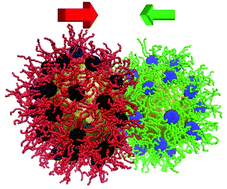Controlling the stability of Pickering emulsions by pH-responsive nanoparticles†
Abstract
Electrostatic dissipative particle dynamics simulations were conducted to model the interactions between emulsion droplets stabilized by pH-sensitive polyelectrolyte-grafted nanoparticles. Using a steered molecular dynamics approach, a mechanistic study of forced coalescence was performed to probe the resistance between two particle-covered droplets. The degree of ionization of the grafted polyelectrolytes was adjusted to capture the pH responsiveness. The maximal resistance forces were measured to quantitatively discriminate the efficacy of particles in stabilizing emulsions at different degrees of ionization. Through analyzing droplet dynamics, resistance force variation, and electric field, we discovered that the resistance is attributed to direct electrostatic repulsion, the image charge effect near the water–oil interface, and steric hindrance among extended polymers. When the particle density on the droplet surface is relatively low, the increasing resistance forces at higher degrees of ionization can effectively prevent droplet coalescence. Oppositely, the ionization compromises emulsion stability when the particle surface coverage is high. Substantial desorption of particles from the interface was triggered as the degree of ionization increases. This in turn reduces resistance force and facilitates coalescence. Moreover, the nanoparticles prevent coalescence at high surface coverages by forming dense layers at individual interfaces, while the particle bridges straddling two interfaces were found at low surface coverages, which can also keep the droplets apart.



 Please wait while we load your content...
Please wait while we load your content...